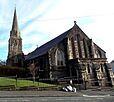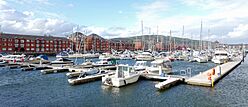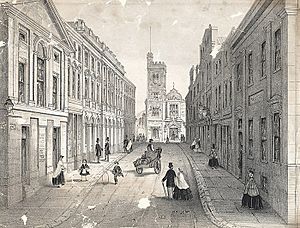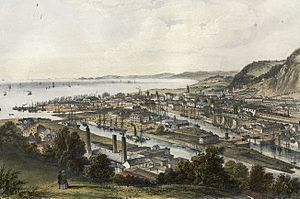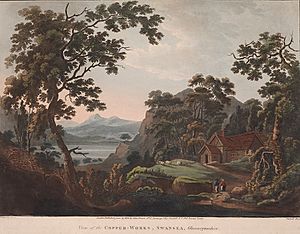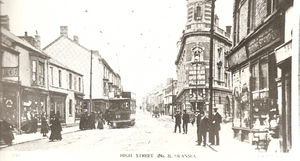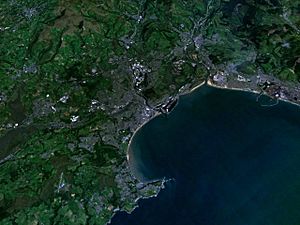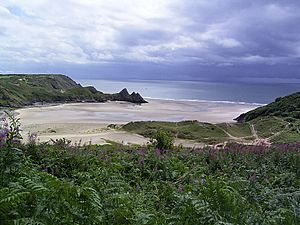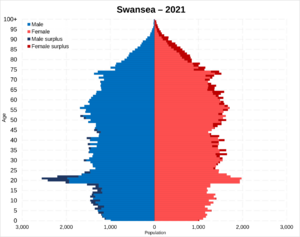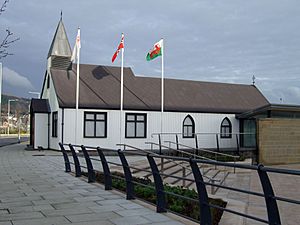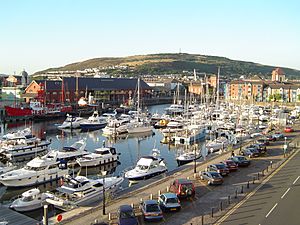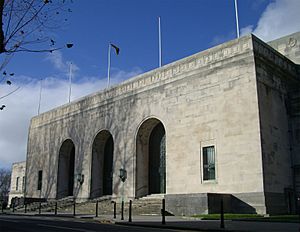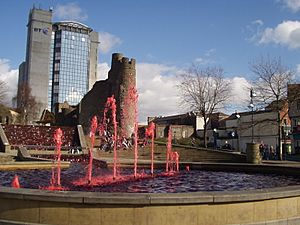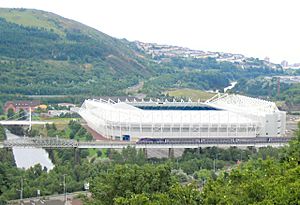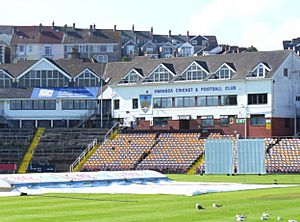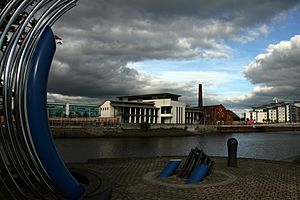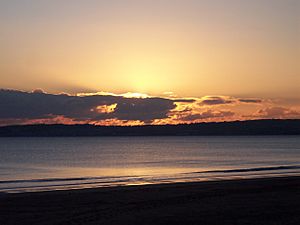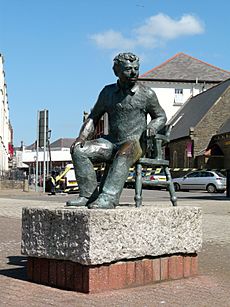Swansea facts for kids
Quick facts for kids
City and County of Swansea
Dinas a Sir Abertawe (Welsh)
|
||
|---|---|---|
|
County and city
|
||
|
Clockwise from top: Swansea City Centre; Swansea Guildhall; St Thomas Church, Swansea; Maritime Quarter; Swansea Castle ruins; Three Cliffs Bay
|
||
|
||
| Motto(s): | ||

Swansea shown within Wales
|
||
| Sovereign state | United Kingdom | |
| Country | Wales | |
| Preserved county | West Glamorgan | |
| Town charter | 1158–1184 | |
| City status | 1969 | |
| Administrative HQ | Guildhall | |
| Government | ||
| • Type | Principal council | |
| • Body | Swansea Council | |
| Area | ||
| • Total | 146 sq mi (378 km2) | |
| Area rank | 14th | |
| Population
(2022)
|
||
| • Total | 241,282 | |
| • Rank | 2nd | |
| • Density | 1,660/sq mi (639/km2) | |
| Ethnicity (2021) | ||
| • Ethnic groups |
List
|
|
| Religion (2021) | ||
| • Religion |
List
47.3% no religion
41.3% Christianity 3.2% Islam 0.4% Hinduism 0.4% Buddhism 0.1% Sikhism 0.1% Judaism 0.5% other 6.7% not stated |
|
| Time zone | UTC+0 (GMT) | |
| • Summer (DST) | UTC+1 (BST) | |
| Postcode areas |
SA1–9
|
|
| Dialling codes | 01792 | |
| ISO 3166 code | GB-SWA | |
| GSS code | W06000011 | |
Swansea is a city on the coast of Wales. It is the second-largest city in Wales. Its official name is the City and County of Swansea.
Swansea is the 25th largest city in the United Kingdom. It sits along Swansea Bay in south-west Wales. The area also includes the beautiful Gower Peninsula. Swansea is part of the historic county of Glamorgan.
The City and County of Swansea is the second most populated local area in Wales. In 2022, about 241,282 people lived there. Swansea, along with nearby Neath and Port Talbot, forms a larger urban area. This area had over 300,000 people in 2011.
In the 1800s, Swansea was a major center for making copper. It was even called Copperopolis because of this.
Contents
- What's in a Name?
- Swansea's Past
- How Swansea is Governed
- Swansea's Landscape
- People of Swansea
- Getting Around Swansea
- Swansea's Culture
- Sports in Swansea
- Future Plans for Swansea
- Swansea's Economy
- Education in Swansea
- Media in Swansea
- Public Services
- Fun and Tourism
- Sister Cities
- Famous People from Swansea
- Images for kids
- See also
What's in a Name?
The Welsh name for Swansea is Abertawe. This means 'mouth of the Tawe River'. This name was probably used for the area before the city was built. The first time the Welsh name was written down was in 1150.
The name Swansea comes from an old Viking trading post. It was founded by King Sweyn Forkbeard around 960–1014. The name combines 'Svein' or 'Sweyn' with '-ey', meaning "island" or "inlet". This might refer to a river bank or an area of raised land in marshland.
Swansea's Past
Ancient Times
The area around Swansea has a very long history. People have lived here since the Palaeolithic (Stone Age). Tools found at Long Hole Cave suggest the first modern humans in Britain lived here. The Red Lady of Paviland, the oldest ceremonial burial in Western Europe, was found here. It dates back to 22,000 BC. There are also many Bronze Age and Iron Age sites. These include burial mounds and hill forts. You can also find the remains of a Roman villa on the Gower Peninsula.
Medieval Swansea
The area was known as Cantref Eginog in ancient times. It was part of Gwyr, a valuable land often fought over by Welsh kingdoms. During the Viking Age, the mouth of the Tawe River became a busy trading spot. A trading post might have been set up between the 9th and 11th centuries.
The area stayed under Welsh control until the Norman Invasion of Wales. Around the early 1100s, Iestyn ap Gwrgant gave the land to Henry de Beaumont, 1st Earl of Warwick. This became the Lordship of Gower.
Henry built Swansea Castle around 1106. Swansea became the main town of the lordship. It received its first borough charter between 1158 and 1184. This charter gave the townspeople special rights to help the area grow. In 1215, King John gave a second charter.
Industrial Growth
From the early 1700s to the late 1800s, Swansea was the world leader in copper-smelting. Many factories along the River Tawe processed copper and other metal ores. These ores came from places like Cornwall, North and South America, Africa, and Australia. This industry earned Swansea the nickname "Copperopolis". However, the industry greatly declined in the late 1800s. Today, none of these copper factories are still working.
Swansea's port first traded in goods like wine, animal hides, wool, and cloth. Later, coal became important. After the invention of the reverbatory furnace in the late 1600s, copper smelting could use coal, which was cheaper than charcoal. Swansea was perfect for smelting Cornish copper ores. It was close to the coalfields of South Wales and had a great port. Shipping copper ore to Wales was cheaper than sending coal to Cornwall.
The first copper factory in Swansea opened in 1717. Many more followed. By the 1850s, Swansea had over 600 furnaces. A fleet of 500 ships carried Welsh coal out and brought metal ore back. Most of the copper from the United States was sent to Swansea for refining.
Factories also processed arsenic, zinc, tin, and other metals. Nearby, they made tinplate and pottery. Swansea's factories were so good at getting gold and silver from ores that they received ores from the United States in the 1800s.
The city grew very quickly in the 18th and 19th centuries. By 1841, Swansea had 6,099 people. This made it larger than Cardiff and the second most populated town in Wales. Much of Swansea's growth came from people moving there from other parts of Wales and beyond.
Copper smelting in Swansea declined for several reasons. Copper mining in Cornwall decreased. The price of copper dropped a lot. Also, new mines in North and South America produced lower-grade copper. It was too expensive to transport this low-grade ore to Swansea.
The Swansea and Mumbles Railway was built in 1804. It moved limestone and coal. It also carried the world's first fare-paying rail passengers. This happened on the same day the British Parliament stopped the transportation of slaves from Africa. The railway later used steam engines, then electric trams. It closed in 1960.
The 20th Century and Beyond
Through the 1900s, heavy industries in Swansea declined. The Lower Swansea Valley was left with old factories and piles of waste. The Lower Swansea Valley Scheme helped clean up and reuse much of this land. The Enterprise Zone is a result of this work. Many of the original docks are now gone. North Dock is now Parc Tawe, a shopping area. South Dock became the Marina.
During the Second World War, Swansea was an important industrial target. German bombs destroyed much of the city center in February 1941. This event is known as the Three Nights Blitz.
In 1969, Swansea was given city status. This was to celebrate Prince Charles becoming the Prince of Wales. The Prince announced this on July 3, 1969. Swansea also gained the right to have a Lord Mayor in 1982.
Today, the city center has the ruins of Swansea Castle. It also has the Marina, the Glynn Vivian Art Gallery, Swansea Museum, the Dylan Thomas Centre, and the Market. The market is the largest covered market in Wales.
Other modern buildings include the BT Tower, Alexandra House, and County Hall. The Swansea Leisure Centre opened in 1977. It was renovated and reopened in 2008.
How Swansea is Governed

The City and County of Swansea is a local government area. It shares borders with Carmarthenshire to the north and Neath Port Talbot to the east. The urban part of Swansea is smaller than the whole county area. It has a population of about 179,485 people.
The local government area covers about 378 square kilometers (146 square miles). This is about 2% of the area of Wales. It includes a lot of open countryside and a central urban area.
Senedd (Welsh Parliament)
Swansea is represented in the Senedd (the Welsh Parliament).
- Gower: The current Member of the Senedd (MS) is Rebecca Evans (Labour Party).
- Swansea East: The current MS is Mike Hedges (Labour Party).
- Swansea West: The current MS is Julie James (Labour Party).
The city is also part of the South Wales West regional constituency.
UK Parliament
Swansea is also represented in the UK parliament.
- Gower: The Member of Parliament (MP) is Tonia Antoniazzi (Labour Party).
- Neath and Swansea East: The MP is Carolyn Harris (Labour Party).
- Swansea West: The MP is Torsten Bell (Labour Party).
Swansea's Landscape
Swansea can be divided into four main physical areas. The land is varied, creating diverse scenery. The Gower Peninsula was the first area in the UK to be named an Area of Outstanding Natural Beauty (AONB). Most of the Gower Peninsula is within this special area. Swansea also has many parks and green spaces.
To the north are the Lliw uplands, which are mostly open moorland. To the east is the coastal area around Swansea Bay. In the middle, from south-east to north-west, is the urban and suburban zone. This stretches from the Swansea city centre to towns like Gorseinon and Pontarddulais. The most populated areas are Morriston, Sketty, and the city center. About three-quarters of Swansea is on the coast.
The Gower Peninsula has Carboniferous Limestone cliffs along its southern edge. It also has salt-marshes and sand dunes to the north. The coasts of the peninsula have many sandy beaches. These are separated by steep cliffs. The South Wales Coalfield reaches the coast in Swansea. This greatly influenced the city's development. The inland area has large grasslands and sandstone ridges.
Much of Swansea is hilly. The main upland area is in the Mawr council ward. Areas up to 185 meters (607 feet) high are found across the central section. Cefn Bryn is a high ridge that forms the backbone of the Gower Peninsula. The highest point is Penlle'r Castell at 374 meters (1,227 feet).
Swansea's Weather
Swansea has a mild temperate oceanic climate. Because it's on the coast, it has milder weather than inland areas. Swansea gets rain from winds coming from the Atlantic Ocean. This also helps keep summer temperatures cooler.
| Climate data for Swansea/Mumbles Head (1991–2020 normals), extremes since 1973 | |||||||||||||
|---|---|---|---|---|---|---|---|---|---|---|---|---|---|
| Month | Jan | Feb | Mar | Apr | May | Jun | Jul | Aug | Sep | Oct | Nov | Dec | Year |
| Record high °C (°F) | 13.5 (56.3) |
13.7 (56.7) |
19.5 (67.1) |
21.8 (71.2) |
24.1 (75.4) |
29.0 (84.2) |
29.0 (84.2) |
31.2 (88.2) |
25.4 (77.7) |
22.4 (72.3) |
16.9 (62.4) |
15.0 (59.0) |
31.2 (88.2) |
| Mean daily maximum °C (°F) | 8.3 (46.9) |
8.3 (46.9) |
9.8 (49.6) |
12.4 (54.3) |
15.2 (59.4) |
17.8 (64.0) |
19.6 (67.3) |
19.7 (67.5) |
18.0 (64.4) |
14.7 (58.5) |
11.5 (52.7) |
9.1 (48.4) |
13.7 (56.7) |
| Daily mean °C (°F) | 6.3 (43.3) |
6.2 (43.2) |
7.0 (44.6) |
9.2 (48.6) |
12.4 (54.3) |
15.0 (59.0) |
16.9 (62.4) |
17.0 (62.6) |
15.4 (59.7) |
12.4 (54.3) |
9.4 (48.9) |
7.1 (44.8) |
11.2 (52.1) |
| Mean daily minimum °C (°F) | 4.3 (39.7) |
4.1 (39.4) |
5.1 (41.2) |
6.9 (44.4) |
9.5 (49.1) |
12.2 (54.0) |
14.1 (57.4) |
14.2 (57.6) |
12.7 (54.9) |
10.1 (50.2) |
7.3 (45.1) |
5.1 (41.2) |
8.8 (47.8) |
| Record low °C (°F) | −9.0 (15.8) |
−6.5 (20.3) |
−5.0 (23.0) |
−2.0 (28.4) |
0.0 (32.0) |
4.0 (39.2) |
8.0 (46.4) |
7.3 (45.1) |
5.0 (41.0) |
0.4 (32.7) |
−2.9 (26.8) |
−5.5 (22.1) |
−9.0 (15.8) |
| Average precipitation mm (inches) | 102.5 (4.04) |
73.7 (2.90) |
69.9 (2.75) |
59.9 (2.36) |
64.5 (2.54) |
68.6 (2.70) |
73.6 (2.90) |
87.7 (3.45) |
76.4 (3.01) |
112.8 (4.44) |
117.9 (4.64) |
114.1 (4.49) |
1,021.6 (40.22) |
| Average precipitation days (≥ 1 mm) | 15.6 | 12.1 | 12.8 | 10.6 | 10.4 | 10.3 | 10.5 | 12.0 | 11.4 | 14.9 | 16.0 | 15.9 | 152.5 |
| Source: Met Office Infoclimat | |||||||||||||
People of Swansea
Swansea's population grew steadily from 1804 until the 1920s. There were slight drops in the 1930s and 1940s. The population grew again in the 1950s and 1960s. It then fell in the 1970s and 1990s. In the 21st century, Swansea has seen a small amount of population growth. In 2007, the area had about 228,100 people. However, by 2021, the population slightly decreased by 0.2%.
About 82% of the people in Swansea were born in Wales. Another 13% were born in England. About 13.4% of the population can speak Welsh.
The main urban area of Swansea had about 179,485 people in 2011. The wider urban area, including Swansea Bay, has a total population of 300,352. This makes it the third largest urban area in Wales.
Most people in Swansea are White British. There are also communities of Asian, Mixed, Black, and other ethnic groups.
Religion in Swansea
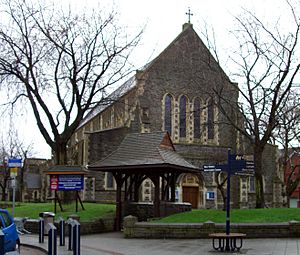
In 2021, about 41.3% of people in Swansea identified as Christian. A large number, 47.3%, said they had no religion. About 6.7% did not state their religion. There are also smaller communities of Muslims (3.2%), Hindus (0.4%), Buddhists (0.4%), Sikhs (0.1%), and Jewish people (0.1%).
Swansea is part of the Anglican Diocese of Swansea and Brecon. It is also part of the Roman Catholic Diocese of Menevia. The main Catholic church is St. Joseph's Cathedral.
Swansea has seen many Non-conformist religious revivals. In 1904, Evan Roberts led a major Protestant revival. This had a big impact on Welsh society.
The Norwegian Church is a historic building in the docklands. It was built as a place of worship for Norwegian sailors. It was moved to Swansea in 1910.
Swansea has several mosques. The Muslim community is raising money for a new central mosque. There are also Buddhist centers, a synagogue, and a Jehovah's Witness Kingdom Hall.
Getting Around Swansea
Roads
The M4 motorway goes around Swansea. It is the main road connecting east and west. The A483 dual carriageway links the city center to the motorway. Other important local roads include the A4067 to Mumbles and the A484 to Llanelli.
Trains
Swansea railway station has services run by two companies.
- Transport for Wales trains go to places like Llanelli, Carmarthen, and Manchester Piccadilly.
- Great Western Railway trains connect Swansea to Cardiff Central, Bristol Parkway, and London Paddington.
Buses and Coaches
Most bus routes in Swansea are run by First Cymru. Smaller companies also operate some routes. Buses go throughout the city, including to hospitals and Swansea University. Regional routes connect Swansea to other towns like Brecon and Cardiff.
Coach services like National Express Coaches and FlixBus offer longer journeys. These go to major cities like London and Birmingham, and to airports.
Park and Ride
Park and ride services are available from car parks at Landore and Fabian Way. This helps people get into the city center without driving all the way.
Air Travel
Swansea Airport is a small airport used for recreational flights. Further development of the airport is not supported by local communities.
Cardiff Airport is about 44 miles (71 km) east of Swansea. It offers scheduled domestic and international flights. It's about 40 minutes away by road.
Sea Travel
Swansea Marina has spaces for 410 leisure boats. More spaces are being built at the Prince of Wales Dock. The Swansea Docks complex handles various cargo, like grain, coal, timber, and steel.
There used to be a ferry service from Swansea to Cork, Ireland, but it ended in 2011.
Cycling
Swansea has four special cycle routes.
- Along Swansea Bay: From the Maritime Quarter to Mumbles Pier.
- Clyne Valley Country Park: Part of the National Cycle Network (NCN) Route 4.
- Along the east bank of the River Tawe: The start of NCN, Route 43.
- Next to the Fabian Way: Part of NCN Route 4 and the Celtic Trail.
A new bridge over the Fabian Way was finished in 2007. It has a bus lane and a path for pedestrians and cyclists.
Swansea's Culture
The Royal Institution of South Wales was founded in 1835. It started as the Swansea Literary and Philosophical Society.
Performing Arts
The Grand Theatre is a Victorian theatre in the city center. It opened in 1897 and holds over a thousand people. It hosts pantomimes, plays, operas, and ballets.
Fluellen Theatre Company is a professional group based in Swansea. They perform at the Grand Theatre and the Dylan Thomas Centre. The Taliesin building at the university also has a theatre.
Other theatres include the Dylan Thomas Theatre and one at Penyrheol Leisure Centre. In summer, outdoor Shakespeare plays are often held at Oystermouth Castle. Singleton Park hosts concerts and parties. The Patti Pavilion is used for music shows and fairs. The Brangwyn Hall is a multi-use venue. It hosts events like graduation ceremonies for Swansea University. Every autumn, Swansea holds a Festival of Music and the Arts. International orchestras visit the Brangwyn Hall.
Swansea is also home to the Palace Theatre. This building, with its unique wedge shape, was built in 1888 as a music hall. It has also been a bingo hall and a nightclub.
In 2018, Singleton Park hosted BBC Music's 'Biggest Weekend'. Famous artists like Ed Sheeran and Taylor Swift performed.
Festivals and Celebrations
Swansea has hosted the National Eisteddfod several times. This is a major Welsh festival of literature, music, and performance. In 2009, Swansea Council started Wales's only week-long St David's Week festival.
Swansea is also known for celebrating Beaujolais Day. People book tables in restaurants and bars up to a year in advance. This is to enjoy the newly released Beaujolais wine. This celebration is thought to bring £5 million to the local economy.
Welsh Language
There are many Welsh language chapels in the area. Education in Welsh is becoming more popular. In 2017, over 1,600 secondary students were taught in Welsh. Nearly twice that number, 3,063 pupils, are taught in Welsh in primary schools.
About 45% of people in the rural Mawr area can speak Welsh. In Pontarddulais, 38% can speak Welsh. Some urban areas like St. Thomas have lower numbers of Welsh speakers.
Local Food
Local foods include cockles and laverbread. These come from the Loughor estuary. Salt marsh lamb, raised in the estuary's salt marshes, is also a local specialty.
Historic Buildings
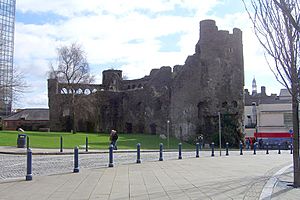
Swansea has three Grade One listed buildings. These are Swansea Castle, the Tabernacle Chapel, Morriston, and the Swansea Guildhall. Swansea Castle was an impressive building. The ruins you see today are from the late 1200s and early 1300s.
The Tabernacle Chapel at Morriston was built in 1872. It is known for its unique semi-circular arches. It has been called the "Nonconformist Cathedral of Wales". The Guildhall is a main office building in the city center. It was designed by Percy Thomas and opened in 1934. It has a tall clock-tower. It is considered a very important building in Wales from its time.
There are also many Grade II* listed buildings. These include the Ebenezer Baptist Chapel, the Glynn Vivian Art Gallery, and the Swansea Museum.
Sports in Swansea
Swansea City A.F.C. is the city's main football team. It was founded in 1912. They moved to the Swansea.com Stadium in 2005. The team now plays in the English English Championship.
Swansea has four other football clubs in the Welsh football league system. These are Swansea University F.C., Garden Village, South Gower, and West End.
Swansea is home to Swansea Rugby Football Club (Swansea RFC). This club helped start the Welsh Rugby Union. They have produced many great Welsh rugby players. In 1935, Swansea became the first club team to beat the All Blacks.
In 2003, Swansea RFC joined with Neath RFC to form the Ospreys. The Ospreys moved to the Liberty Stadium in 2005. They have won the Celtic League four times.
St Helens Rugby and Cricket Ground is the home of Swansea RFC. It is famous because Sir Garfield Sobers hit six sixes in one over here. This was the first time this happened in a first-class cricket game.
The Swansea Bowls Stadium opened in 2008. It has hosted international bowls championships.
Future Plans for Swansea

Swansea city center is getting a huge makeover. A large area is planned for redevelopment. A new shopping area is being built. This will involve tearing down the old St. David's Shopping Centre. The new retail area will be much larger than the current Quadrant Centre.
The city center is also being made brighter with street art and new walkways. New green spaces will be added.
At the seafront, The Tower, Meridian Quay is Wales's tallest building. It is 107 meters (351 feet) high. It has a restaurant on the top floor. It was finished in 2010 near Swansea Marina.
Swansea's Economy
Swansea first grew as a center for metals and mining, especially copper. By the 1880s, 60% of the copper imported to Britain was processed here. After the Second World War, these heavy industries declined. Swansea then shifted towards a service sector economy.
Out of 105,900 people working in Swansea, over 90% are in service jobs. Many work in public administration, education, health, banking, and finance. This shows Swansea's role as a service hub for South West Wales.
Economic activity and employment rates in Swansea are slightly above the Welsh average. In 2007, the average full-time earnings were £21,577. This was similar to the Welsh average.
Swansea is home to the DVLA headquarters in Morriston. It employs about 6,000 people. Other major employers include Admiral Group, HSBC, Virgin Media, and Amazon.co.uk. Virgin Atlantic has its largest contact center in Swansea.
Education in Swansea
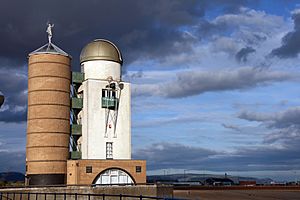
Colleges and Universities
Swansea University has a campus in Singleton Park. Its engineering department is known for its work on solving engineering problems. The physics department is famous for research in theoretical physics. Many other departments have received "excellent" ratings. In 2015, Swansea University opened a new Bay Campus. In 2005, the university won an award for the UK's "best student experience". In 2017, Swansea University Medical School was ranked as the third best medical school in the UK.
Other places for further education include University of Wales Trinity Saint David and Gower College Swansea. Trinity Saint David was formed in 2010. In 2013, Swansea Metropolitan University joined Trinity Saint David. Swansea Metropolitan University was known for its Architectural Glass department.
Schools
Swansea has one nursery school, six infant schools, and five junior schools. There are 77 primary schools. Ten of these teach in Welsh. There are 15 comprehensive (secondary) schools. Two of these are Welsh-medium schools. There are also six special schools.
The oldest school in Swansea is Bishop Gore School, founded in 1682. The largest comprehensive school is Olchfa School. There is one Roman Catholic comprehensive school, Bishop Vaughan Catholic Comprehensive School. Other secondary schools include Birchgrove Comprehensive School and Gowerton School. The two Welsh-medium secondary schools are Ysgol Gyfun Gymraeg Gŵyr and Ysgol Gyfun Gymraeg Bryn Tawe.
Independent schools in Swansea include Ffynone House School and Oakleigh House School.
Media in Swansea
The local newspaper is the Swansea edition of the South Wales Evening Post. The Metro is a free daily paper distributed in the city. The council also produces a free monthly newspaper called the Swansea Leader. Swansea Life is a monthly lifestyle magazine.
Swansea has five local radio stations. These include Hits Radio South Wales and Heart South Wales. A community radio station, Radio Tircoed, serves the western suburbs. Radio City 1386AM is the hospital radio station for Singleton Hospital. Xtreme Radio is run by Swansea University.
The local television service, That's Swansea Bay, started in July 2016. The BBC has had a studio in Swansea since 1924. Dylan Thomas worked here in the 1930s. The studio can broadcast live radio and television.
In 2008, the BBC put a large permanent television screen in Castle Square.
Independent filmmakers Undercurrents and Studio8 are based in Swansea. The city also hosts the BeyondTV Film Festival. Swansea has hosted the annual Swansea Bay Film Festival.
Public Services
The South Wales Police force patrols Swansea. The regional headquarters is at Swansea Central Police Station.
Ambulance services are provided by the Welsh Ambulance Service. Fire services are provided by the Mid and West Wales Fire and Rescue Service. Swansea Airport is one of Wales's three Air Ambulance bases.
Local healthcare services are run by Swansea Bay University Health Board. They operate two hospitals in Swansea: Singleton Hospital and Morriston Hospital. Morriston Hospital has Accident and Emergency services.
The local council manages waste services. This includes collecting rubbish and recycling. They also operate five recycling centers.
Western Power Distribution supplies electricity to Swansea. Welsh Water provides drinking water and wastewater services. The local gas company is Wales and West Utilities.
Fun and Tourism
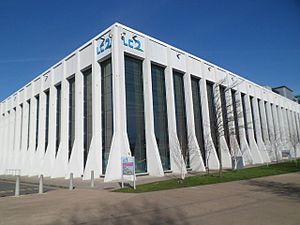
Many beaches around Swansea Bay attract visitors. You can go surfing at Langland Bay, Caswell Bay, and Llangennith. The 5-mile (8 km) promenade from the Marina to Mumbles offers great views. The village of Mumbles has a Victorian pier. It also has small shops, restaurants, and cafes. The south coast of Gower is popular for walkers. A path stretches from Mumbles Head to Rhossili.
On the waterfront, Swansea Bay has a beautiful coastline. It features a beach, promenade, and a marina. The National Waterfront Museum and Swansea Museum are in the maritime quarter. The Dylan Thomas Centre celebrates the life and work of the author. The Dylan Thomas Birthplace and Home has been restored to how it looked when he was born. The SA1 Waterfront area is a new place for living, dining, and leisure.
Swansea Bay, Mumbles, and Gower have many parks and gardens. They also have almost 20 nature reserves. Clyne Gardens has a collection of plants. Singleton Park has parkland, a botanical garden, and a boating lake. Plantasia is a tropical pyramid with unusual plants, monkeys, reptiles, and butterflies. Other parks include Cwmdonkin Park, where Dylan Thomas played as a child.
Oxwich Bay on the Gower Peninsula was named the most beautiful beach in Britain in 2007. It has over three miles (5 km) of sand. Rhossili Bay has been called the "British supermodel of beaches". It was also listed as one of the 25 best beaches in the world. Llangennith Beach is known as a great place to learn to surf. Three Cliffs Bay was voted Britain's best camping beach.
Several beaches have won Blue Flag Beach Awards. These include Bracelet Bay, Caswell Bay, Langland Bay, Port Eynon Bay, and Swansea Marina.
Activities to Enjoy
Swansea offers many activities like sailing, water skiing, surfing, walking, and cycling. Part of the Celtic Trail and the National Cycle Network, Swansea Bay has traffic-free cycle routes. These include paths along the seafront and through Clyne Valley Country Park. There are also several golf courses.
The Swansea Leisure Centre was redeveloped into an indoor waterpark called the LC. It was opened by Queen Elizabeth II in 2008. The Wales National Pool is also in Swansea.
Nightlife and Entertainment
Swansea has many pubs, bars, clubs, and restaurants. Most city center bars are on Wind Street. Some places offer live music. The "Mumbles Mile" used to be a famous pub crawl. However, many pubs have now become flats or restaurants.
Sister Cities
Swansea is twinned with:
It also has a friendship link with Nantong, China.
Famous People from Swansea
- The poet Dylan Thomas is perhaps the most famous. He was born and grew up in Swansea. He wrote much of his work from his bedroom. There is a memorial to him in Cwmdonkin Park. He described Swansea as an "ugly lovely town".
- The Vivian family helped develop Swansea in the 1800s. They made their money from copper mining. Their former homes are now places like Singleton Abbey (used by Swansea University) and Clyne Castle.
- Rowan Williams, who was the Archbishop of Canterbury, was born in Swansea.
- Actress Catherine Zeta-Jones was born and raised in Swansea. She still owns a home in Mumbles.
- Non Stanford, the 2013 ITU Triathlon World Champion, is from Swansea.
- The thriller writer, Mark Ellis, went to school in Swansea.
- Philosopher Rush Rhees taught at Swansea University.
- Dr Who screenwriter Russell T Davies was born in Swansea.
- Actor Matt Ryan (known for Assassin's Creed and Constantine) is from Swansea. When he auditioned for Assassin's Creed Black Flag, they liked his Welsh accent so much they changed his character's background to be from Swansea.
People from Swansea are often called "Swansea Jacks" or just "Jacks". The reason for this nickname is not fully clear. Some think it comes from Swansea Jack, a life-saving dog.
Images for kids
See also
 In Spanish: Swansea para niños
In Spanish: Swansea para niños






